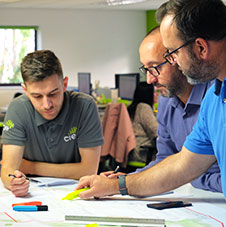Auracast – The Future of Assistive Listening Technology
Auracast is set to transform how millions of people experience sound — making the world more inclusive, accessible, and connected than ever before.
Across the UK, more than 18 million people are deaf, have hearing loss, or tinnitus — that’s 1 in 3 adults. Everyday situations like following conversations in busy environments, listening to announcements in public spaces, or watching TV with family can be exhausting or even impossible. While hearing aids and assistive listening systems (ALS) help, existing technology often falls short due to poor availability, limited compatibility, or reliance on extra equipment.
Auracast is a new global Bluetooth standard designed to change that. By enabling high-quality, universal audio broadcasting directly to devices like hearing aids, cochlear implants, earbuds, and smartphones, Auracast opens the door to clear, accessible

What is Auracast?
Auracast is part of the next generation of Bluetooth LE Audio. Unlike traditional Bluetooth, which pairs devices one-to-one, Auracast allows a single audio stream to be broadcast to many receivers at once. That means:
- TVs, laptops, smartphones, and PA systems can act as transmitters.
- Users simply “tune in” with their hearing device, earbuds, or phone.
- Multiple streams can exist in one space (for example, different TV channels in a gym).
From GP surgeries and lecture theatres to public transport, cinemas, and social gatherings, Auracast has the potential to remove barriers and reduce listening effort for people with hearing loss, while offering new convenience for everyone.
How Auracast Works
Auracast works by turning everyday devices into audio transmitters. A TV, smartphone, laptop, or public address system can broadcast high-quality digital audio using Bluetooth LE Audio. Any compatible receiver — such as a hearing aid, cochlear implant, earbuds, or smartphone — can then “tune in” to that stream, just like connecting to Wi-Fi. To make selection simple, an Auracast assistant (for example, a phone app or smartwatch) helps users choose the right stream. Multiple broadcasts can exist in the same space — such as different TV channels in a gym or separate announcements in a transport hub — giving people the flexibility to connect to exactly what they need, when they need it.

Why Auracast Matters
For people with hearing loss, Auracast isn’t just another piece of tech — it’s a lifeline to inclusion.
- Clearer sound in noisy spaces: Whether on a train platform or in a crowded restaurant, Auracast delivers audio directly to your device, cutting through background noise.
- Reduced stigma: Because it works with everyday consumer devices like earbuds, using Auracast doesn’t single anyone out.
- Lower cost & wider availability: More devices will ship with Auracast built in, meaning greater choice and affordability compared to older ALS systems.
- More reliable access: With mass adoption expected in smartphones and hearing aids from 2025/26, Auracast is set to become the mainstream solution for assistive listening.
Auracast in Practice
Auracast isn’t just a technical upgrade — it’s a practical solution that improves everyday life. Some of the key situations where Auracast can make a difference include:
-
Watching TV at home – users can stream clear audio from the TV directly into their hearing aids, earbuds, or phones, without disturbing others.
- Tour guides & exercise classes – instructors can broadcast their voice to a whole group, making it easy for everyone to follow along, even in noisy environments.
- Meetings & group conversations – in business or social settings, Auracast helps cut through background noise so participants can clearly hear the speaker or focus on chosen voices.
- Healthcare appointments – GP consultations and waiting room announcements can be transmitted directly to patients’ devices, ensuring important information is never missed.
- Public transport – travel announcements at stations or on buses and trains can be broadcast via Auracast, giving passengers reliable access to essential updates.
- Cinemas, theatres & museums – venues can transmit multiple audio streams, such as dialogue-enhanced tracks, audio description, or translations, to make culture and entertainment more inclusive.
In each of these scenarios, Auracast removes barriers, reduces listening effort, and allows people with hearing loss to engage fully in shared experiences
The Road Ahead
The rollout of Auracast has already begun, with Auracast-enabled devices appearing since 2023. Industry experts predict mass adoption will accelerate as Android and iOS platforms introduce support in 2025/26, with full rollout expected over the next decade.
Until then, existing hearing loops and ALS must continue to be maintained to ensure no one is excluded during the transition. But the future is clear: Auracast will become the standard for inclusive audio access, helping people connect better at home, at work, in healthcare, and across national infrastructure.
The Future of Inclusive Listening
Auracast represents a game-changing step forward in accessibility. For millions living with hearing loss, it promises clearer communication, greater independence, and fuller participation in everyday life. For society, it marks a shift towards technology designed to include, not exclude — ensuring everyone can share the same experiences, equally.
|
|
Featured Products











